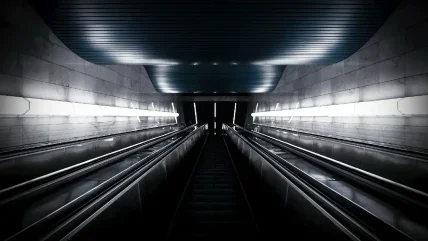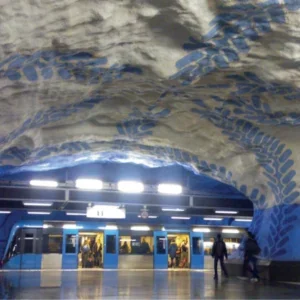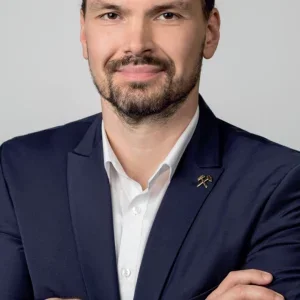
Speed, scale, size: the superlatives for the expansion of Moscow’s rail infrastructure system come thick and fast. The entire off-street rail transport development programme, begun in 2011, includes construction of no fewer than 120 new stations by 2024. By then, the rail transport system of the metropolis will have doubled in size to exceed 1,000km. Its new ‘Big Circle’ will be the longest circle rail line in the world.
One statistic gives an idea of this massive undertaking: while most metro expansions operate a handful of TBMs at most, Moscow has had no fewer than 23 of them in operation on a single day – and thus entered the Guiness Book of World Records.
The unprecedented pace of development of the network – consisting of the Metro, the Moscow Central Circle (MCC) and the Moscow Central Diameters (MCD) – became possible thanks to high-end technologies implemented by Russian engineers.
Anna Merkulova, engineer, member of the British Tunnelling Society and ITA, and CEO of the Mosproekt-3 Group of Companies – a key player in the Moscow mega-project – tells Tunnels and Tunnelling International about the work being done.
Moscow’s metro system has been a source of pride since its original construction during the Stalin era in the 1930s. Its stations are renowned for their spaciousness and palatial interior design. Fifty years later, visitors to the city still marvel at the lavish attention paid to a public transportation system originally built to make life easier for the proletariat.
But Moscow has grown and so has its transport needs. The system consisted of lines emanating out from the city centre in a radial pattern – known as ‘diameters’ – with few cross-connections between them. Furthermore, road congestion was growing.
“In 2010, the city administration decided on accelerated renovation of its entire transport system,” explains Merkulova.
“In doing so, it gave priority to the Metro – historically the most popular type of public transport in the capital. Seven million passengers use it daily, which amounts to 2.5 billion rides a year.
“The large-scale programme of expansion of the underground network was aimed at extending its outreach to cover 90% of the city’s population. As a first stage, seven of the existing radial lines were extended, adding 27 new stations to the existing ones. While that was happening, five new radial lines were begun, with 60 new stations on them. Twenty of them have already been completed.
“An important goal of the programme is to give increased flexibility in navigating the city. To achieve that goal, it was necessary to create additional lateral connections between the radial lines, with convenient interchange hubs. Such a line – the Moscow Central Circle, or MCC (Line 14) – already existed, but in Soviet times it was used for freight transport. In 2016 it was converted to passenger use, and from the moment it became operational, passenger traffic on it has been higher than even the most optimistic estimates. Currently, comfortable ‘Lastochka’ (in English, ‘Swallow’, as in the bird) trains operate on a scheduled basis, and stations are integrated into the suburban railroad system, the Moscow Central Diameters.
“Most of the interchange hubs between the MCC and the diameters were built by the Mosproekt-3 team. They have become additional points of growth for the city, zones of balanced homes and jobs.
“A second circle project is now under construction. This is the Big Circle Line, (BCL). It will have no fewer than 31 stations, and it is this that has become the real symbol of the Moscow metro planning programme. Once the circle is complete, it will be the longest in the world, at 70km, surpassing that of the Beijing underground. And it is on the BCL that Guinness World Records experts have documented 23 tunnel-boring machines working simultaneously to build the line – though in total we have more than 30 TBMs, including four 10m-diameter ones, in use on the tunnels.
“As of today, the tunnels of the BCL are 97% complete. Most of the work was done by 6m-diameter TBMs, but around 15km of tunnels were bored using the 10-meter machines, to allow double rail tracks. With the launching of yet another section of the BCL this year, more than 17km of the new line will become available for passengers. The circle is expected to be completed in 2023.
“All this of course has required an immense concentration of technological resources and expertise. Specialists from Europeans and Asian countries have taken part in some stages of implementing the programme. In particular, our team cooperated with Spanish project designers; it was they who suggested the idea of double-track tunnel boring using TBMs. We also worked on a section of the BCL with Chinese construction specialists who brought to Moscow six tunnelling shields.
“Although Russian specialists have vast experience in the construction of deep metro networks in both rock and unstable soil, we increased the pace of the programme by placing most of the new sections close to the surface rather than deep down. For the same reason, to increase speed of construction, we are using standard designs for the stations.
“Some sections required the classic approach used for boring tunnels through mountains. The geology of the Moscow region sometimes provides difficult working conditions: we often encounter water sands which can liquefy under pressure, fissured rocky soil, and high- and low-plasticity clay. We also have to deal with overburden pressure and hydrostatic pressure. Among the technologies that our engineers used were dry- and brine-freezing, soil cement stabilisation, drill-and-blast tunnelling with sprayed-concrete lining (SCL), as well as boring with cutter-loader machines.
“New Moscow is a new residential and industrial urban district and there we have unique experience of building an overland section of the metro. The Mosproekt-3 team implemented the project within a record-setting period of two years. New Moscow is similar to the Grand Paris regeneration concept. Although the Russian project was launched later than the French one, it has achieved first results much earlier. Its overland rail section runs within an integrated framework beside a highway and has a fancy futuristic design of cover structures which protect it from precipitation and ensures the safety of the lane.” (Moscow has seen record-breaking snowfalls in recent winters). “Such solutions have never been used before in the Moscow Metro, and our engineers had to do a lot of work regarding norms and regulations to finish the project.
“The Russian government at the state level pays great attention to information technologies in construction works. Starting from next year, BIM becomes mandatory for all government contracts. For the last several years, we at Mosproekt-3 have proactively implemented information modelling technologies in our work. We have taken part in developing regulatory standards, have trained highly-qualified specialists who implement BIM and have carried out several major projects using BIM. As a result, we have become the prime BIM-company in infrastructure building in Russia.
“Our specialists have moved from sporadic use of information modelling technologies to building the first metro facility in Russia created completely in a BIM environment. With each completed BIM project, we have enlarged our database and component library and have codified our BIM frameworks that regulate the rules of exchange and administration of information about facilities under construction. We have also developed a common work-flow that uses open formats among others and allows us to combine the best solutions from different vendors. Today, our team is increasing the capabilities of digital models by integrating software for network planning graphs, analytical calculations of fire spread and evacuation, comprehensive soil geomechanical models and others.
“BIM allows us to build infrastructure facilities more effectively in the dense conditions of a metropolis. For example, we have used digital modelling for the overland section of the Metro in New Moscow to optimise station utility systems. Initially, the lane had been designed for a high-speed tram system. The stations of another radial line – Troitskaya, that goes into areas recently added to the Moscow city jurisdiction – are tightly sited between residential buildings and the road network. With the help of BIM, we can thoroughly search for potential conflicts and address them at the design stage of the project.
“I think the state initiative of widespread implementation of BIM will give significant momentum to the development of innovative technologies in Russia.
“In the field of underground infrastructure, our continuing work on the Moscow Metro development programme has ensured an unprecedented leap forward – and at very great speed. Of course, there’s no permanent need for such a pace, so now Moscow authorities are switching to a steadier rhythm of work. Nonetheless, another 58km of tunnels and 24 stations are to be built; the projects of the third and fourth lines of the MCD are in the active phase of implementation; and the plans to build the fifth one have been already made public, so there is plenty still for us to do.
“For the future, administrations of several other Russian metropolises have launched their transport development programmes. These plans have received support from the president and the federal government. For example, not so long ago, the Mosproekt-3 team became involved in the Metrotram project in Chelyabinsk. Light speed-tram systems are common in European cities, but in this case we face a unique challenge of integrating the tunnels of an unfinished metro project into the transport network.
“While the Russian market has vast potential, we nevertheless have offers and give consideration to projects in Europe and the Middle East. I’m convinced that the immense experience and advanced skills gained by the Mosproekt-3 team while working on the unprecedented development programme of the Moscow Metro will ensure ultimate quality of construction of facilities for our foreign partners.”






